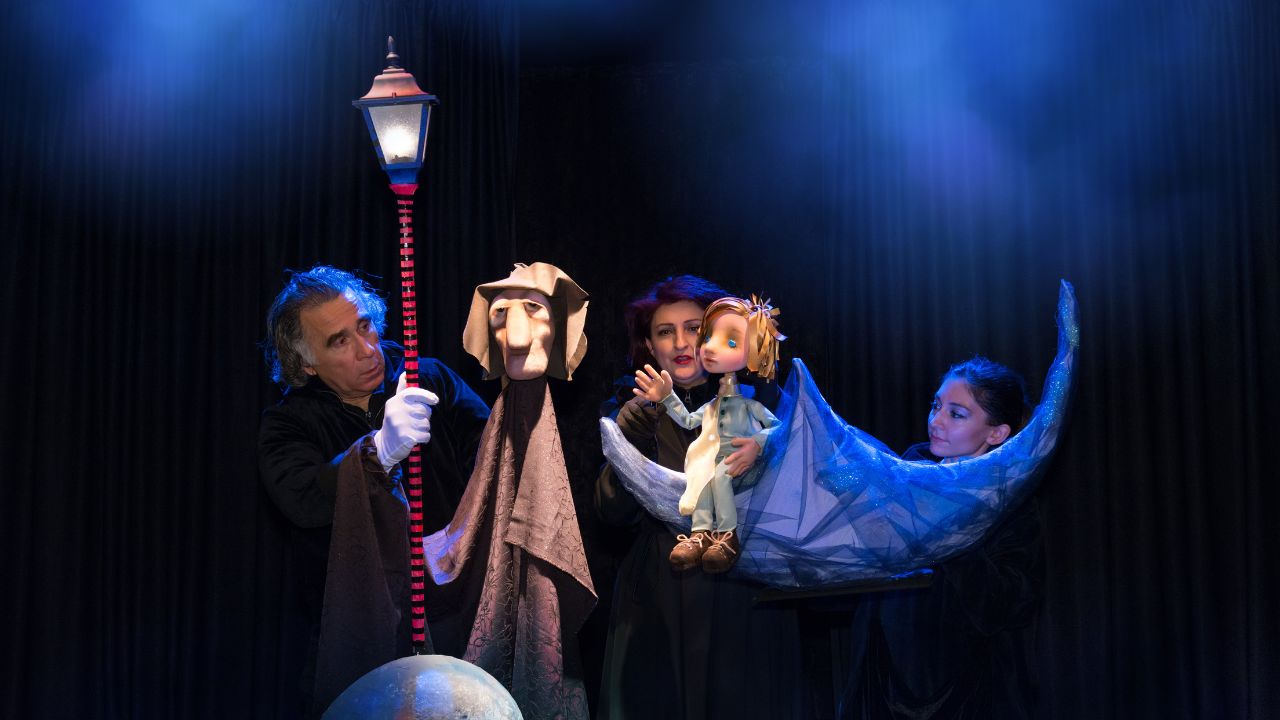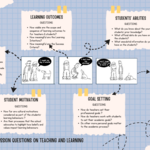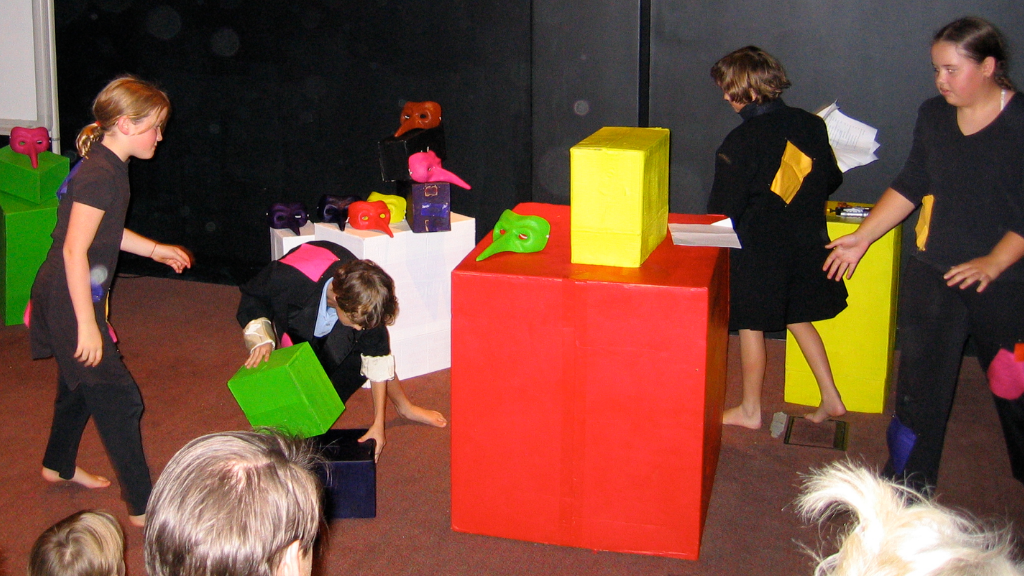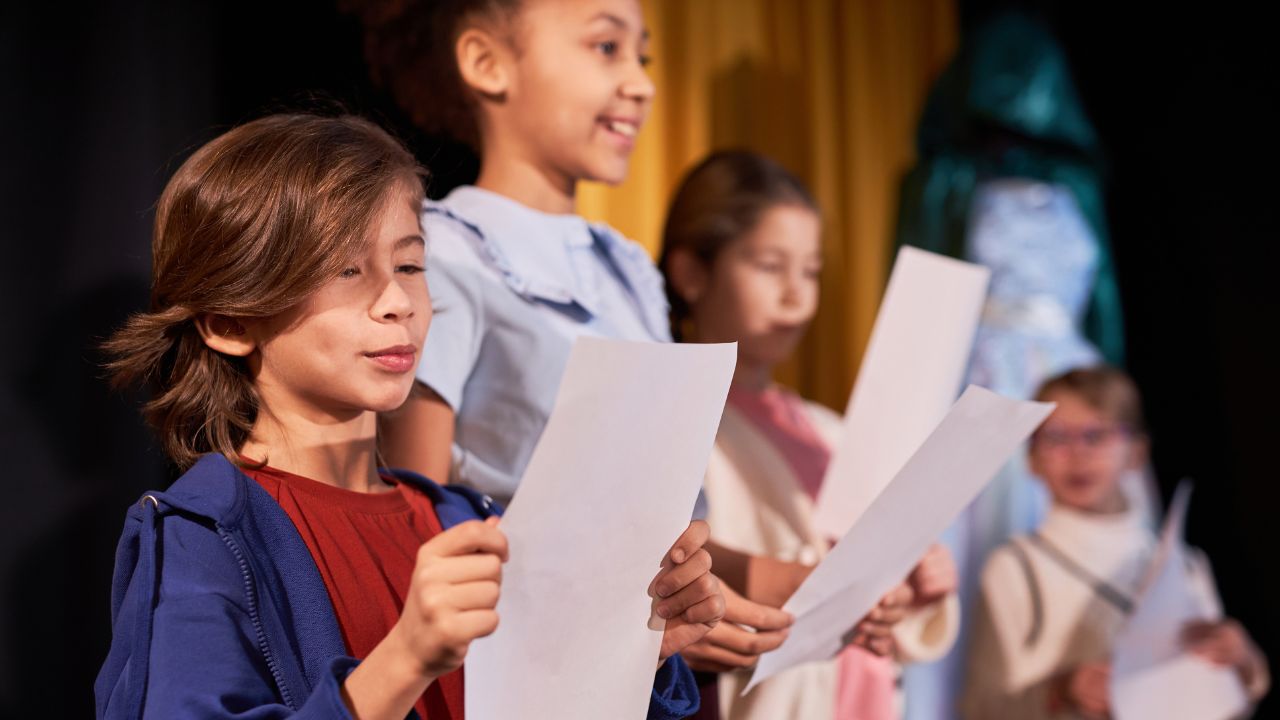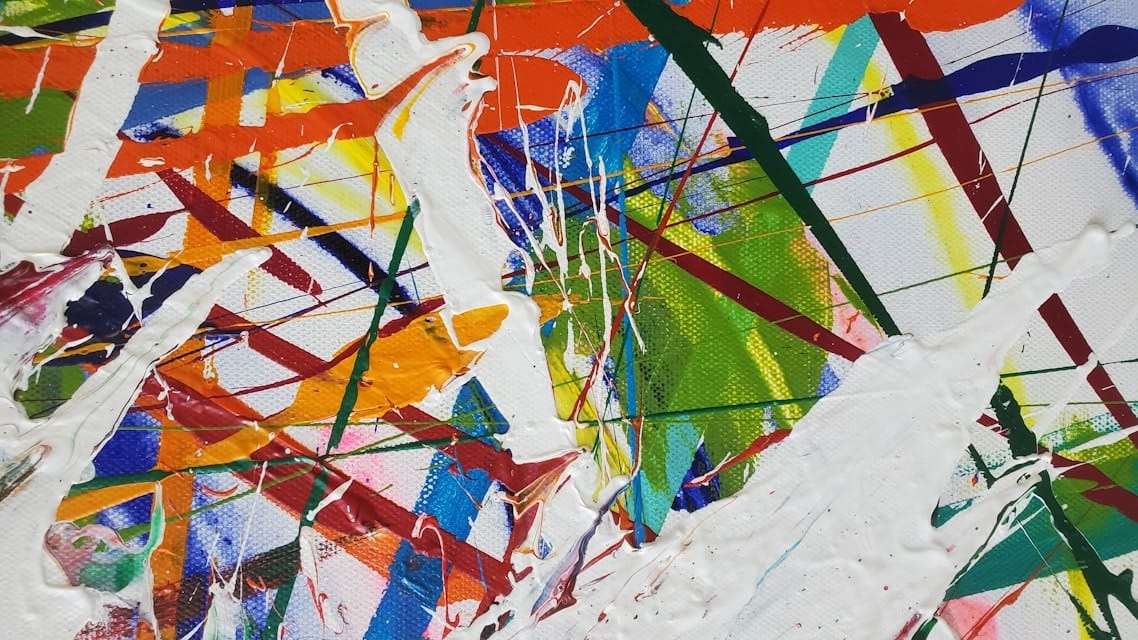The elements of drama are character and relationships, climax, conflict, context, setting, contrast, dramatic meaning, mood, sound, space, time, symbol and tension.
Elements of Drama
In drama, this refers to the roles played by actors, and are created during devising or in a presentation or performance to an audience. Characters are inherent in scripts and plays from early theatre forms to contemporary theatre forms and are central to stories and storytelling. Students create character(s) in drama and consider their function, purpose, objective(s), motivation(s), status, and traits or qualities. When developing, creating and sustaining characters, actors also consider the relationships of that character to self and others.
Related Terms
Actor, Actor-audience relationship, Expressive skills (Voice, Movement, Gesture, Facial expression), Transformation.
Definitions of Related Terms
Actor: In drama, an actor is a performer whose role is to portray character(s) in a devised work or in the interpretation of a script. Actors use expressive and performance skills to establish character and to maintain and/or manipulate an actor-audience relationship.
Actor-audience relationship: In drama, actors present their work to audiences. In creating dramatic works, actors consider the intention of the drama, the playwright, the space in which the drama is being presented and the impact they wish to have on an audience. Actors work together to create a particular relationship with an audience, which can be established, maintained and manipulated through the use of expressive and performance skills and the application of design areas.
Expressive skills: In drama, expressive skills are manipulated by an actor to achieve character, create meaning and demonstrate intention in drama works and theatre performances. In drama, expressive skills are voice, movement, gesture, facial expression, and stillness and silence.
Transformation: In drama, transformation refers to techniques or methods used by actors to transform or transition between characters, place and/or time in front of an audience. Actors may use their voice, movement, gesture, level changes, the manipulation of an object or prop, sound, a word or other technique to enable the transformation to occur.
In drama, climax can occur as the most significant moment of tension or conflict. There may be more than one climax in a drama.
Related Terms
Conflict, Tension, Dramatic meaning.
Definitions of Related Terms
Conflict: In drama, conflict generally occurs when a character cannot achieve an objective or purpose due to an obstacle. The obstacle may be something within themselves, such as a feeling, or it may be external and between characters.
Tension: Tension is the suspense that holds an audience’s attention as a presentation or performance unfolds. Tension can be created through the use of space, silence, performance energy, sound or other, and may have comic or dramatic effect.
Dramatic meaning: Dramatic meaning refers to the ideas and intentions that are conveyed to an audience, and how the audience understands these from watching a presentation or performance.
In drama, conflict generally occurs when a character cannot achieve an objective or purpose due to an obstacle. The obstacle may be something within themselves, such as a feeling, or it may be external and between characters. It may also be between a character and their environment or greater situation. Conflict may be shown in a variety of ways, through physical or verbal means or through the use of design areas.
Related Terms
Character and relationships, Climax, Tension, Dramatic meaning.
Definitions of Related Terms
Character and relationships: In drama, this refers to the roles played by actors, and are created during devising or in a presentation or performance to an audience.
Climax: In drama, climax can occur as the most significant moment of tension or conflict.
Tension: Tension is the suspense that holds an audience’s attention as a presentation or performance unfolds.
Dramatic meaning: Dramatic meaning refers to the ideas and intentions that are conveyed to an audience, and how the audience understands these from watching a presentation or performance.
The context in drama is the frame of reference that allows the meaning of the drama to be interpreted. Interpretation of the meaning of a drama work can evolve from the context. The context of a drama work or theatre performance can be the location and time in which it is made, presented or viewed. Context can also be the economic, philosophical, historical, social or cultural influences on the practices of the artist/playwright, their intentions, and their communication of ideas, values and beliefs.
Related Terms
Country, Place, Setting, Style, Genre, Form.
Definitions of Related Terms
Country: The physical environment that a particular Aboriginal and Torres Strait Islander Peoples’ group has a relationship with. Referring to this territory as ‘Country’, rather than land, indicates a reciprocal and deep relationship and one where Country both owns and is owned by the People.
Place: For Torres Strait Islander Peoples, ‘Place’ is a space mapped out that individuals or groups occupy and regard as their own and that has varying degrees of spirituality. For Aboriginal Peoples, ‘Place’ refers to the special places that exist within Country, the purposes of which vary significantly.
Setting: Setting refers to the location and place within the drama or theatre work.
Style: In drama, style refers to theatre styles and recognised conventions. These may relate to historical and contemporary practices in the theatre and may include particular theatre practitioners, scripts and design areas.
Genre: A type of theatre or drama that represents a particular form, culture or historical era. For example, Ancient Greek theatre, Elizabethan theatre, or contemporary Indigenous theatre.
Form: In drama, form is aligned with specific drama practices and performance styles, particularly in relation to contemporary drama practices.
Contrast presents aspects or moments that are dissimilar in a drama, created to highlight or emphasise differences between characters, settings, times, themes, design areas or styles. Contrast may be shown through differences within expressive and performance skills such as voice, movement, gesture, focus and mood.
Related Terms
Design areas, Expressive skills, Performance skills, Mood, Style.
Definitions of Related Terms
Design areas: In drama, design areas are creative areas that contribute to the meaning, style, form and presentation and/or performance of drama and theatre. Design areas include costume, make-up and hair, props, set and set pieces, sound and lighting.
Expressive skills: In drama, expressive skills are manipulated by an actor to achieve character, create meaning and demonstrate intention. They include voice, movement, gesture, facial expression, and stillness and silence.
Performance skills: In drama, performance skills are used to communicate story, enhance meaning and realise intention. They include actor-audience relationship, energy, focus and timing.
Mood: Mood is the overall feeling or emotion that a presentation or performance may evoke for an audience.
Style: In drama, style refers to theatre styles and recognised conventions.
Dramatic meaning refers to the ideas and intentions that are conveyed to an audience, and how the audience understands these from watching a presentation or performance. Dramatic meaning can be conveyed through dialogue, movement, character, structure, form, actor-audience relationship and use of design areas.
Related Terms
Actor-audience relationship, Audience, Symbol, Theme, Concept.
Definitions of Related Terms
Actor-audience relationship: In drama, this is a performance skill where actors consider the intention, space, and desired impact to create, maintain and manipulate a particular relationship with the audience.
Audience(s): Individuals or groups of people who experience drama and theatre presentations through intellectual, emotional and social engagement.
Symbol: Symbol refers to the creation of meaning that is representational rather than literal.
Theme: The principal idea or connection of ideas and concepts in a drama work or performance.
Concept: A thought, idea or notion related to a theoretical construct, which is generally the primary idea or influence behind a drama work.
Mood is the overall feeling or emotion that a presentation or performance may evoke for an audience. Mood may be achieved through the application of particular conventions, the manipulation of expressive and performance skills, and design areas.
Related Terms
Aesthetic knowledge, Conventions, Design areas, Expressive skills, Performance skills.
Definitions of Related Terms
Aesthetic knowledge: An understanding of how the conventions, materials and techniques of a drama work together to influence the mood or emotion.
Conventions: Traditionally, stylistically or culturally accepted ways of doing things, such as direct address, tableau, or heightened use of language.
Design areas: Creative areas that contribute to the meaning, style and form, such as costume, props, set, lighting, and sound.
Expressive skills: Skills manipulated by an actor to achieve character and create meaning, such as voice, movement, gesture, and facial expression.
Performance skills: Skills used to communicate story and enhance meaning, such as energy, focus, and timing.
Setting refers to the location and place within the drama or theatre work.
Related Terms
Context, Place, Country, Space, Design areas.
Definitions of Related Terms
Context: The frame of reference that allows the meaning of the drama to be interpreted, including the location, time, and cultural influences.
Place: Special places within Country (for Aboriginal Peoples) or a mapped-out space with spiritual significance (for Torres Strait Islander Peoples).
Country: The physical environment that a particular Aboriginal and Torres Strait Islander Peoples’ group has a deep and reciprocal relationship with.
Space: The way a performance area is used to communicate meaning, define a location, and represent character status.
Design areas: Creative areas that contribute to meaning, including set and set pieces, lighting, and sound.
Sound is used to enhance meaning. Sound may be created live by a performer during a presentation or performance through voice, body percussion such as clapping or striking the body, the use of objects, or a combination to create an audible effect. Sound could also include live accompaniment. In design areas, sound generally relates to the creation of recorded sound design or soundtrack.
Related Terms
Design areas, Voice, Stillness and silence, Technologies.
Definitions of Related Terms
Design areas: Creative areas that contribute to the meaning, style, and form of a drama, including the creation of recorded sound design or soundtracks.
Voice: An expressive skill where actors use and manipulate their voice through accent, pitch, pace, tone, etc.
Stillness and silence: An expressive skill found when there is a simultaneously sustained absence of sound and movement.
Technologies: Manual, mechanical, electrical or digital tools used to make drama and enhance meaning, including lighting, sound equipment, and projection.
Space involves the way a performance area is used to communicate meaning, define a location, represent the status of characters and create an actor-audience relationship.
Related Terms
Actor-audience relationship, Setting, Place, Country, Tension.
Definitions of Related Terms
Actor-audience relationship: A performance skill where actors create a particular relationship with the audience, which can be manipulated through the use of space.
Setting: The location and place within the drama or theatre work.
Place: Special places within Country or a mapped-out space with spiritual significance.
Country: The physical environment an Aboriginal or Torres Strait Islander Peoples’ group has a deep relationship with.
Tension: The suspense that holds an audience’s attention, which can be created through the use of space.
Symbol refers to the creation of meaning that is representational rather than literal. Symbol can be created through the use of actions, gesture, language, movement, facial expressions, objects, costumes, set, lighting and sound.
Related Terms
Design areas, Gesture, Movement, Prop, Found objects.
Definitions of Related Terms
Design areas: Creative areas like costumes, set, lighting, and sound, which can be used to create symbolic meaning.
Gesture: An expressive skill relating to the way an actor uses the body (commonly arms and hands) to convey meaning, which can be symbolic.
Movement: An expressive skill involving the use of the body to express character and convey meaning.
Prop: An object used by an actor that is portable on a stage or set.
Found objects: A natural or human-created object found by an artist and incorporated into a performance to enhance meaning.
Tension is the suspense that holds an audience’s attention as a presentation or performance unfolds. Tension can be created through the use of space, silence, performance energy, sound or other, and may have comic or dramatic effect.
Related Terms
Climax, Conflict, Energy, Focus, Stillness and silence, Timing.
Definitions of Related Terms
Climax: The most significant moment of tension or conflict in a drama.
Conflict: Occurs when a character cannot achieve an objective due to an obstacle.
Energy: A performance skill; the intensity an actor brings to a performance. High energy can be used to create a moment of tension.
Focus: A performance skill; the ability of an actor to commit to their performance and guide the audience’s attention.
Stillness and silence: The sustained absence of sound and movement, used to create tension.
Timing: A performance skill referring to the pace, rhythm and tempo of moments.
Time describes the fictional time or setting in a drama performance.
Related Terms
Context, Setting, Timing, Transformation.
Definitions of Related Terms
Context: The frame of reference for the drama, which includes the time in which it is made, presented or viewed.
Setting: The location and place within the drama.
Timing: A performance skill referring to the timing (pace, rhythm, and tempo) of one moment to the next.
Transformation: Techniques used by actors to transition between characters, place, and/or time.

